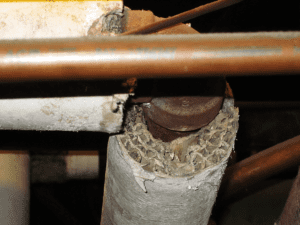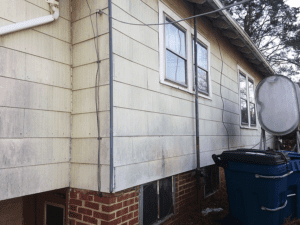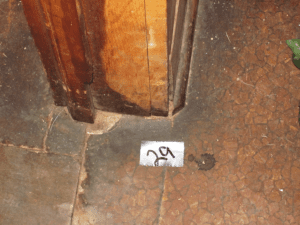How to address the presence of asbestos
 Do you own or are you thinking of purchasing a building that may have asbestos? Do you know about the potential damage it may cause to your health and your bottom line? To reduce the risk of expensive removal and exposure to asbestos, it is important to learn about the possible presence and the condition of asbestos in your structure. We know there is a great deal of misunderstanding surrounding the dangers of asbestos, but the air quality experts at EMS are well-versed in answering and addressing our clients’ questions about asbestos, as well as questions from homeowners and business owners alike.
Do you own or are you thinking of purchasing a building that may have asbestos? Do you know about the potential damage it may cause to your health and your bottom line? To reduce the risk of expensive removal and exposure to asbestos, it is important to learn about the possible presence and the condition of asbestos in your structure. We know there is a great deal of misunderstanding surrounding the dangers of asbestos, but the air quality experts at EMS are well-versed in answering and addressing our clients’ questions about asbestos, as well as questions from homeowners and business owners alike.
In this article, we will briefly discuss asbestos and will provide you with the 10 most frequently asked questions about asbestos, complete with responses from our EMS professionals.
What is asbestos?
Asbestos is a naturally-occurring group of minerals that are structured as bundles of fibers. There are six primary types of asbestos: Chrysotile, Amosite (brown asbestos), Crocidolite (blue asbestos), Tremolite, Anthophyllite, and Actinolite.
Top 10 Questions About Asbestos
What are asbestos fibers?
An asbestos fiber is a particulate form of asbestos that is five micrometers or longer, with a length-to-diameter ratio of 3 to 1. Disturbed fibers may become airborne and remain airborne for long periods of time due to their size, shape, and low density—which makes them undetectable by the naked eye.
What are the health risks associated with asbestos in my building?
Health risks are presented when asbestos fibers become airborne, increasing the chance of inhalation. Upon inhalation, asbestos fibers build up in the lungs and make it difficult to breathe. Asbestosis, mesothelioma, and lung cancer are three of the most common and most serious health issues associated with asbestos exposure. Undisturbed asbestos fibers are unlikely to pose health risks to occupants of the building. As long as it is in good condition, asbestos fibers should not become airborne, therefore decreasing the risk of inhalation.
What is ACM and how is it defined?
ACM stands for asbestos-containing material. ACM is defined as any material containing more than 1% asbestos. Out of the six primary types of asbestos, Chrysotile makes up 95% of all asbestos in use. Chrysotile is used in roofs, ceilings, walls, and floors of homes and businesses.
What materials are common asbestos-containing materials?
Prior to the 1980s, asbestos was a common component used in building material, automotive parts, and textiles because of its fire-resistant, durable, and flexible nature. It is no longer mined or processed in the United States but is still used in vinyl floor tiles, brake pads, and cement pipes.
There are also many materials that are still legally used in construction, renovation, and demolition processes. Piping, spray-applied and blown-in insulation, mastic, roofing material, caulking, and exterior building materials, cement siding, HVAC duct insulation, roofing shingles, spackling compounds, and fireproofing materials, to name a few.
My building was constructed in the 1980s. Wasn’t asbestos use banned by then?
No. The EPA banned most asbestos-containing products in the U.S. in 1989. However, the rule was vacated in 1991 which overturned bans on the manufacture, importation, processing, and distribution in commerce. Only the bans on corrugated paper, rollboard, commercial paper, specialty paper, and flooring felt remained under the 1989 rule. While the production and use of asbestos has significantly declined, most asbestos-containing products can still be legally manufactured, imported, processed, and distributed in the U.S.
Does ACM need to be identified during a Phase I Environmental Site Assessment?
No. Identification of asbestos is not part of the American Society of Testing and Materials (ASTM) E-1527 standards. While it is not required to identify asbestos during a Phase I ESA, it may be a good idea to incorporate an asbestos survey in your due diligence.
Does the ACM need to be sampled and identified prior to renovation/demolition?
Yes, especially in cases where the material will be disturbed or the building is going to be demolished. EPA recommends a visual and physical evaluation of ACM during the inspections to note the ACM’s current condition and physical characteristics. Through this inspection, it is possible to determine or assess the likelihood of future fiber release.
There are instances where it is not necessary to remove asbestos from a commercial building prior to renovation/demolition. If the total amount of asbestos to be removed is less than 260 linear feet, 160 square feet, or 35 cubic feet off of facility components, the asbestos does not need to be removed, so as to avoid disturbance and prevent fibers from becoming airborne.
Can I collect my own samples and remove asbestos myself?
Most states allow homeowners of the residence to collect samples and remove asbestos without any special licensing or training, though it may not be a wise decision as it is dangerous to your health. However, sampling and removal of asbestos from a commercial structure must be done by a licensed professional.
Does an ACM survey need to be completed in order to obtain a building demolition permit?
Yes, a full ACM survey is required per most building demolition permits, as well as a lead survey. Information gathered during the thorough inspection allows the owner or operator to determine which requirements of the National Emission Standards for Hazardous Air Pollutants (NESHAP) for asbestos will apply to the demolition or renovation project. The asbestos NESHAP prohibits the reinstallation or installation of any insulating materials that contain commercial asbestos if the materials are either molded and friable or wet-applied and friable after drying. It is not recommended that other asbestos containing materials be reused.
What is a Positive Stop Analysis?
Positive Stop Analysis refers to a laboratory analysis protocol that analyzes multiple samples of similar material and stops analysis when asbestos is identified at concentrations greater than 1%. This can lower the overall cost of an inspection by directing the laboratory to stop further analysis of additional samples collected from the similar material.
Education is the Key to Protecting your Real Estate Investment
Reducing the risk of financial liability and serious health issues begins with understanding how to detect and handle asbestos-containing material. While the use of ACM in homes and commercial structures in the U.S. has greatly decreased since the 1980s, your building or the building you are looking to purchase may still have asbestos in its building materials.
If you have questions about asbestos, ACM, health effects related to exposure, or any other related questions we may not have covered in this article, please feel free to reach out to us!
For more information about indoor air quality, check out these related articles:



Thanks for the advice to not remove asbestos alone; especially if you don’t have any training. I didn’t know that it could be hazardous to one’s health. If someone were worried about having asbestos in their home or office building, I would suggest air monitoring services.
My mom has always been a bit of a worrier, and I think that she’s been wanting to have some asbestos inspections done after doing some reading. You talked about needing to have a physical evaluation during the inspection to determine whether or not fiber release is possible or likely with asbestos. I’m going to have to see if I can find her a good asbestos inspection service and get her taken care of so she knows she has nothing to worry about!
I didn’t know that asbestos is still used in some materials in the US, like vinyl tiles or brake pads. I thought they stopped using it in the 80’s, but I guess that didn’t apply to everything. My house was built in the 70’s, so I wonder if there is asbestos in it. I should probably have it checked to be sure.
Thanks for the information about asbestos. My neighbor said that he might have asbestos in his home, so I thought I would look into it. I didn’t realize that any building before the 80’s might have asbestos. I will definitely have to have my house checked, because it is pretty old.
I really appreciate you saying that it might not be wise to remove asbestos yourself. My husband wants to try his hand at asbestos removal in the house we want to buy. He doesn’t have any training, and I don’t want him to get sick, so maybe it’s better to leave it to the professionals.
I’m glad that you mention how asbestos can be dangerous to remove without the right training so it’s important to hire a licensed professional. When choosing a professional, it would probably be important to research the different options by looking online. This could help you find one that has the right skills and equipment to handle the removal and disposal of the asbestos without harming anyone while also ensuring that it’s completely removed.
I appreciate you for explaining that the removal of asbestos should only be done by a professional since it is highly dangerous to one’s health. I will make sure that my brother will hire one because he tends to do things on his own. Recently, he found out that he has asbestos in his basement when he was cleaning that part of the house to make it as his workshop in the future. Thanks for the information!
I had no idea that asbestos fibers could build up in the lungs and make it hard to breathe. You also mentioned that it causes cancer, but it this because it is toxic or the fibers are damaging the lungs over time? My home is older, so I’ve been wanting to get it checked for asbestos. Thanks for explaining more about what asbestos is and how to deal with it!
I like that you mentioned the risk of health issues when you try and tackle a asbestos problem yourself. For me, this is simply not worth it. I would much rather hire a professional and avoid any health hazards.
My wife and I live in a 1980s home and we think that there might be asbestos in the walls. We called a commercial asbestos abatement company to come and inspect our walls to find out for sure. I thought that the asbestos was banned well before 1989 so I found that part interesting in your article.